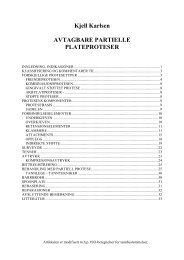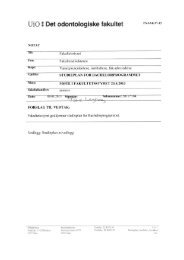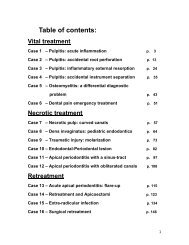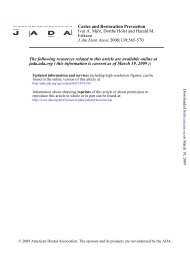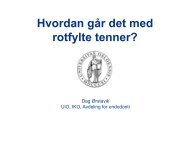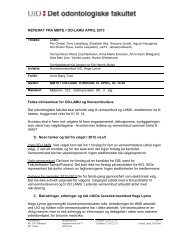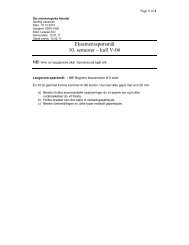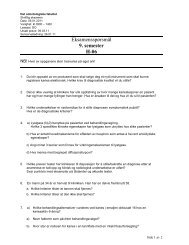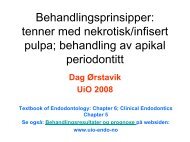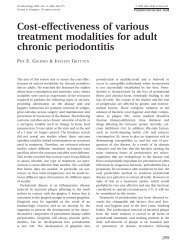Optimal post length and diameter and microleakage of ...
Optimal post length and diameter and microleakage of ...
Optimal post length and diameter and microleakage of ...
- No tags were found...
You also want an ePaper? Increase the reach of your titles
YUMPU automatically turns print PDFs into web optimized ePapers that Google loves.
Post <strong>and</strong> core• The primary purpose<strong>of</strong> a <strong>post</strong> is to retain acore that can be usedto retain the defeniteprosthesisWooden dental prostesis<strong>of</strong> the Tokugawa era(1603-1867)
Do <strong>post</strong>s reinforceendodontically treated teeth?
• Lovdahl <strong>and</strong> Nicholls (1977)• Guzy <strong>and</strong> Nicholls (1979)• Trope et al (1985)
What are the most commontypes <strong>of</strong> <strong>post</strong> <strong>and</strong> core failures?• Dislodgement <strong>and</strong> loosening• Root fracture• Caries <strong>and</strong> apical lesions
Factors affecting the retention• Post <strong>length</strong>• Post <strong>diameter</strong>• Post design• Luting agents• Luting method• Canal shape• Preparation <strong>of</strong> the canal space <strong>and</strong> tooth• Location in the dental arch
• Various guidelines have been recommendedregarding <strong>post</strong> <strong>length</strong>– The <strong>post</strong> should be equal <strong>of</strong> the crown– The <strong>post</strong> should be 1/3 the <strong>length</strong> <strong>of</strong> the crown– The <strong>post</strong> should be ½, 2/3, or 4/5– The <strong>post</strong> should end halfway betwen the crestal bone<strong>and</strong> the root apex– The <strong>post</strong> should be as long as possible withoutdisturbing the apical seal
Post <strong>length</strong>• Studies have reported that the <strong>length</strong> <strong>of</strong> the <strong>post</strong>has a significant effect on its retention <strong>and</strong> inmost instances, the more deeply the <strong>post</strong> isplaced, the more retentive it becomes (St<strong>and</strong>leeet al 1978)• Leary et al (1987) found that <strong>post</strong>s with <strong>length</strong> <strong>of</strong>at least 3-quarters <strong>of</strong> the <strong>length</strong> <strong>of</strong> the root<strong>of</strong>fered the greatest rigidity <strong>and</strong> least rootdeflection when compared with <strong>post</strong>s that werehalf the root <strong>length</strong>
Post <strong>length</strong>• From laboratory studies,it is apparent that a <strong>length</strong>guideline ideally wouldbe three fourths <strong>of</strong> theroot <strong>length</strong>, but thisdimension is notachievable withoutcompromising the apicalseal on many teeth
Post <strong>diameter</strong>• Increasing the <strong>diameter</strong> <strong>of</strong> the <strong>post</strong> does notprovide a significant increase in the retention<strong>of</strong> the <strong>post</strong> (St<strong>and</strong>lee et al 1978, Sorensen et al1984, Hunter et al 1989)• However it can increase the stiffness <strong>of</strong> the<strong>post</strong> at the expense <strong>of</strong> the remaining dentin<strong>and</strong> the fracture resistance <strong>of</strong> the root (Tropeet al, Mattison et al 1982, Trabert et al 1978)
Post <strong>diameter</strong>• Goodacre et al suggested that <strong>post</strong><strong>diameter</strong>s should not exceed one third <strong>of</strong> theroot <strong>diameter</strong> at any location• Studies also indicate that the <strong>diameter</strong> at thetip should usually be 1 mm or less(Goodacre et al, Abou-Rass et al 1982)
Camp et al (1983)determined that when4 mm <strong>of</strong> gutta perchawas retained only 1 <strong>of</strong>89 specimens showedleakage, whereas 32 <strong>of</strong>89 specimens leakedwhen 2 mm <strong>of</strong> guttapercha was retained
Madison, Zakarison(1984) <strong>and</strong> Neagley(1969) found noleakage at 4 mm
Zmener (1980)found that in rootcanals sealed withlateralcondensationtechnique, leakagewas reduced whenmore than 4 mm <strong>of</strong>gutta-percharemained in theapical portion
• Portell et al (1982) determined that most <strong>of</strong> thespecimens with only 3 mm <strong>of</strong> apical gutta perchahad some leakage• Mattison et al (1984) found significantdifferences between 3, 5, <strong>and</strong> 7 mm <strong>of</strong> guttapercha, <strong>and</strong> they concluded that at least 5 mm <strong>of</strong>gutta percha is necessary for an adequate apicalseal
Post space preparation <strong>and</strong>leakage• During the mechanical preparation <strong>of</strong> the <strong>post</strong>space it is possible that the root filling may betwisted or vibrated, with disruption <strong>of</strong> the seal• It now seems that the advantages <strong>of</strong> leaving theapical portion <strong>of</strong> the root filling undisturbed isoutweighed by the fact that much <strong>of</strong> the canalsystem is vulnerable to contamination from aninadequate seal coronally
• Provided a minimum <strong>of</strong> 5 mm <strong>of</strong> sound apicalroot filling is left in situ, studies have shown thatremoval <strong>of</strong> laterally condensed gutta percha doesnot affect the apical seal, irrespective <strong>of</strong> whetherthe <strong>post</strong> space is prepared immediately afterobturation or is delayed (Zmener 1980, Neagley1969, Bourgeois et al 1981)
• The success <strong>of</strong> endodontic therapy iscommonly thought <strong>of</strong> in terms <strong>of</strong> an adequateapical seal• However, the coronal seal achieved by therestoration may be considered as importantfor the ultimate success <strong>of</strong> endodontictreatment (Marshall et al, Swanson et al,Torabinejad et al, Magura et al. Khayat et al,Ray et al, Tronstad et al)
Strinberg, in 1956,considered that the mostcommon cause <strong>of</strong> failurewas leakage <strong>of</strong> tissuefluids apically aroundinadequate root fillingsIngle in 1965 found that<strong>of</strong> 104 failed cases, 66were associated with apoor apical seal
Importance <strong>of</strong> coronal leakage infailure <strong>of</strong> root canal treatment• Obturated root canals can be recontaminatedby micro-organisms in a number <strong>of</strong> ways:– Delay in placing a coronal restoration. Temporarymaterials will dissolve slowly after in time in thepresence <strong>of</strong> saliva <strong>and</strong> the seal may break down. Atemporary restoration <strong>of</strong> inadequate thickness willeventually leak
Importance <strong>of</strong> coronal leakage infailure <strong>of</strong> root canal treatment– Fracture <strong>of</strong> the coronal restoration <strong>and</strong> /or thetooth– Preparation <strong>of</strong> <strong>post</strong> space when the remainingapical section <strong>of</strong> the root filling is <strong>of</strong> inadequatedensity <strong>and</strong> / or <strong>length</strong>
Coronal leakage…• The concept that one cause <strong>of</strong> failure <strong>of</strong> rootcanal treatment may be the result <strong>of</strong> coronalleakage is not a new one• Marshall & Massler, in 1961, carried out aleakage study using a radioactive tracer <strong>and</strong>showed that coronal leakage occurred despitethe presence <strong>of</strong> a coronal dressing
Allison et al, in1979 made briefreference to thepossibility that apoor coronal sealmight contribute toclinical failure
Swanson & Madison,in 1987, did an in vitrostudy where theyshowed that after only3 days exposure toartificial saliva therewas extensive coronalleakage <strong>of</strong> a tracer dyethrough aparentlysound root filling
Madison & Wilcox,in 1988, confirmedthat exposure <strong>of</strong> rootcanals to the oralenvironment allowedcoronal leakage totake place, in somecases along the whole<strong>length</strong> <strong>of</strong> the rootcanals
Torabinejad et al, in 1990,found that 50% <strong>of</strong> singlerootedteeth, root filledusing lateral condensation<strong>of</strong> gutta percha <strong>and</strong> a sealercement, were contaminatedwith bacteria along thewhole <strong>length</strong> <strong>of</strong> the rootafter 19 days or 42 days,depending upon thecontaminating organism
Khayat et al, in 1993, haveshown that root canalsobturated with gutta percha<strong>and</strong> Roth’s sealer, usingeither lateral condensationor vertical condensationwere contaminated apicallywith bacteria from salivaexposed to the coronal part<strong>of</strong> the root canal only. Allcanals were contaminatedwithin 30 days <strong>of</strong> exposure
MicroleakageActual bacterial penetration throughobturating materials may not be necessaryto cause treatment failure. Moreimportant may be leakage <strong>of</strong> bacterial byproductsBacterial metabolites, toxins <strong>and</strong>degradation products are much smallerthan bacteria <strong>and</strong> could penetrate fasterHovl<strong>and</strong> & Dumsha, in 1985, showed thatmost leakage occurs between the rootcanal sealer <strong>and</strong> the wall <strong>of</strong> the root canal
Prokaryptic cells(bacteria) are thesmallest <strong>of</strong> theunicellularorganisms. Theyare, for the mostpart,approximately 1 to1.5 µm wide <strong>and</strong> 2to 6 µm longEscherichia coli is approximately1 µm in <strong>diameter</strong>
Bacterial mechanism <strong>of</strong> tissuedamage <strong>and</strong> bacterial productsBacterial factors forcolonization <strong>and</strong> growthBacterial factors forinvasion <strong>and</strong> tissue damage
Bacterial factors for invasion<strong>and</strong> tissue damageDirectIndirectCytotoxicproductsEnzymesInflammatoryresponseTissue damage
Enzymes• Collagenase• Trypsin-like protease• Gelatinase• Aminopeptidase• Phospholipase A• Alkaline phosphotase• Acid phosphotase• hyaluronidase
Toxic factors• Bone resorbing factors– Lipoteichoic acid– Lipopolysaccharide– Capsule• Cytotoxins– Butyric <strong>and</strong> propionicacids– Indole– Amines– Ammonia– Volitile sulphurcompounds
Microleakage <strong>of</strong>endodonticallytreated teethrestored with<strong>post</strong>sBachicha et al. 1998
Purpose• To measure by fluid filtration the <strong>microleakage</strong><strong>of</strong> a stainless-steel <strong>post</strong> system <strong>and</strong> a carbonfiber<strong>post</strong> system cemented with zinc phosphate<strong>and</strong> glass ionomer as nondentin-bondingcements, <strong>and</strong> Panavia-21 <strong>and</strong> C& B Metabondas dentin-bonding cements
Microleakage ….• Leakage <strong>of</strong> endodontic obturation materials hasbeen measured by:– Dyes (Swanson et al, Madison et al)– Radioactive isotopes (Marshall et al)– Bacteria (Mortensen et al, Goldman et al, Torabinejadet al)
Fluid filtration system• Was developed by Derksen et al. 1986 tomeasure quantitatively <strong>microleakage</strong> aroundcoronal restorations
The movement <strong>of</strong> the airbubble in themicropipette toward theapical end <strong>of</strong> the root perunit time provided ameans <strong>of</strong> measuring<strong>microleakage</strong> as fluidmoved from inside theroot toward the externalsurface
ControlExperimental
µl/min0,40,350,30,250,20,150,10,050SS PostCF PostZn Phos Glass Ion Panavia-21 C & B MetaMicroleakage
0,40,350,30,25Zn PhosGlass IonPanavia-21C & B Metaµl/min0,20,150,10,050SS PostCF PostMicroleakage
ConclusionBased on the observations <strong>of</strong> the present study,using the accelerating leakage pressures, itseems that the dentin-bonding cements haveless <strong>microleakage</strong> than the traditional,nondentin-bonding cements



